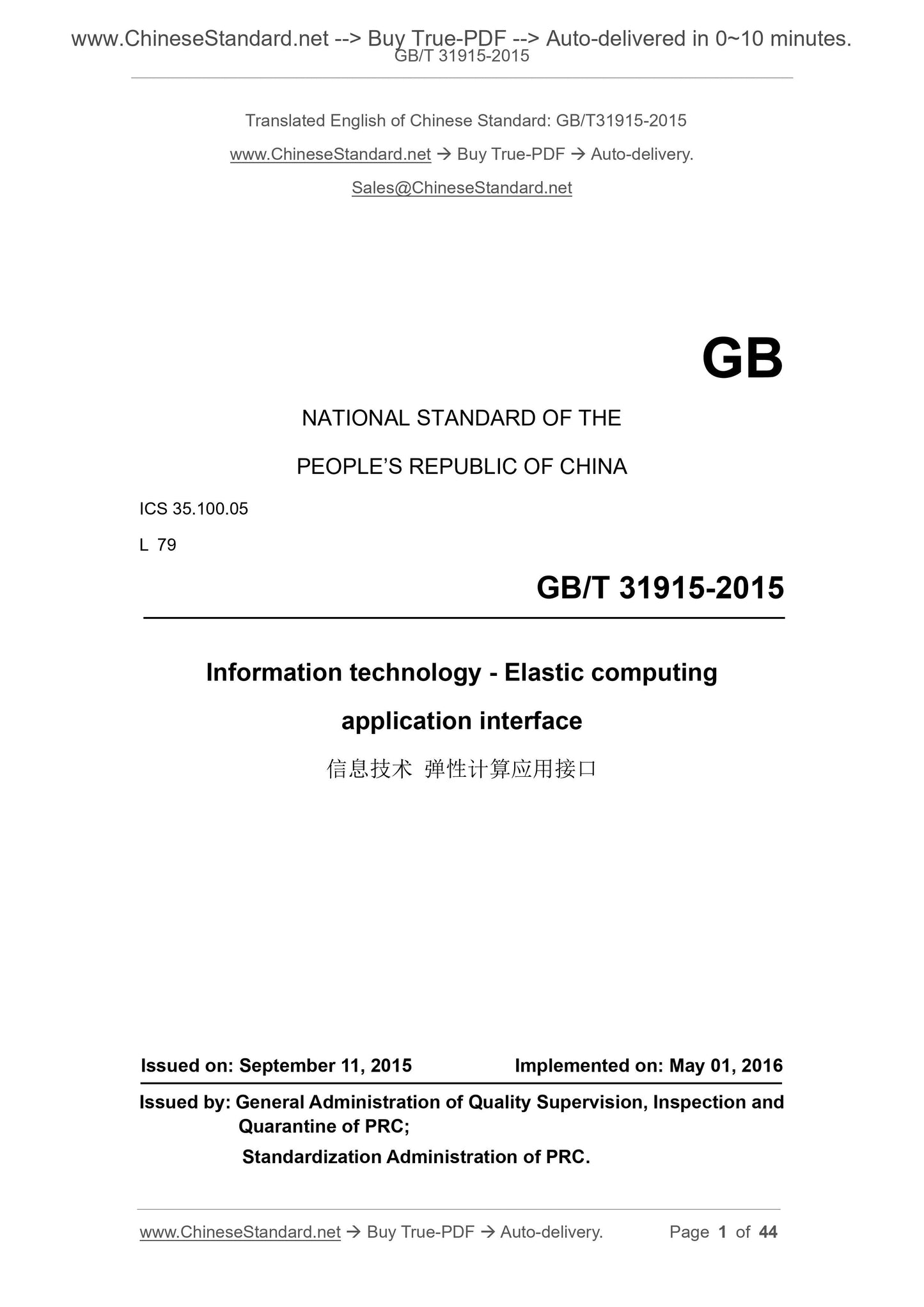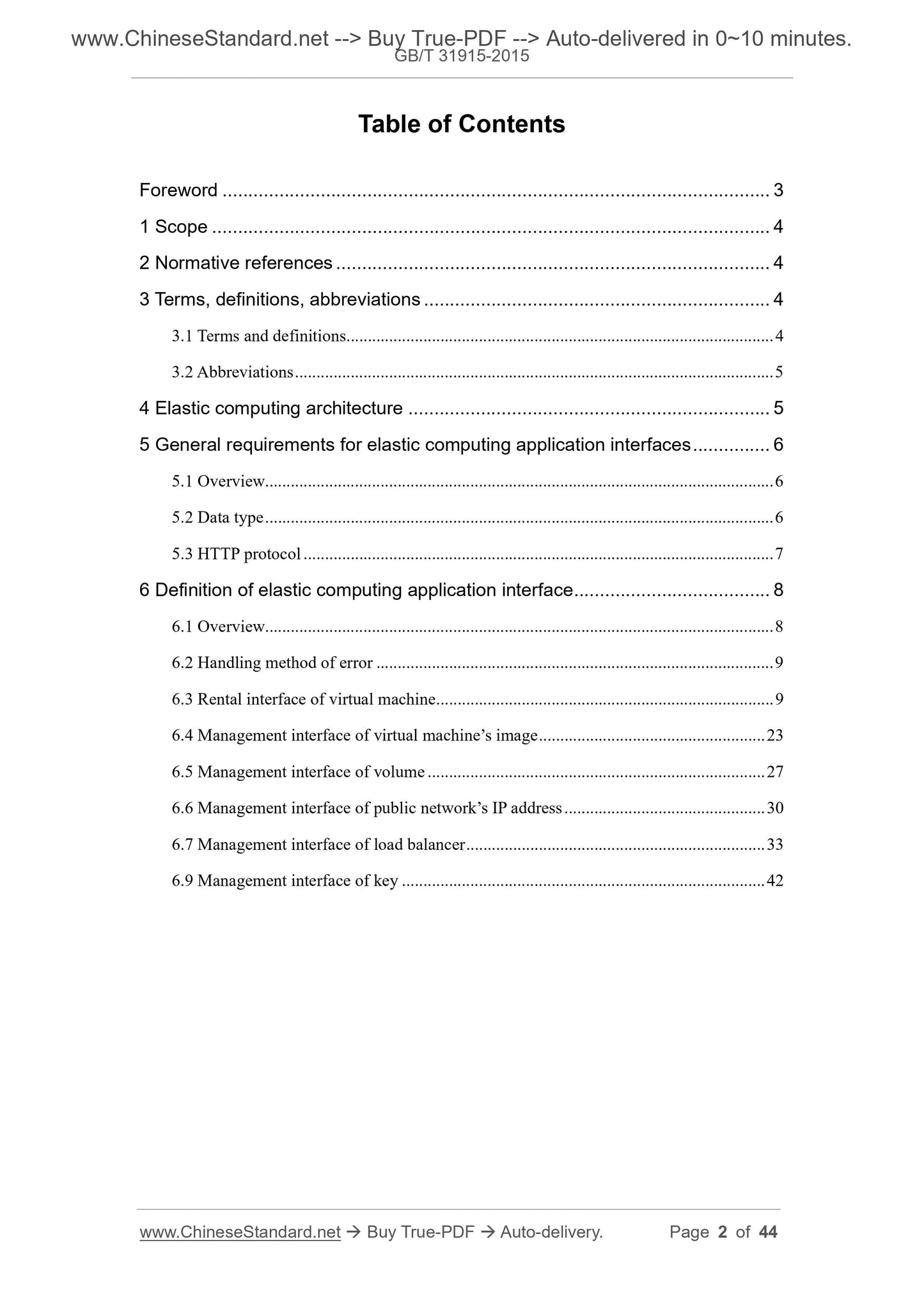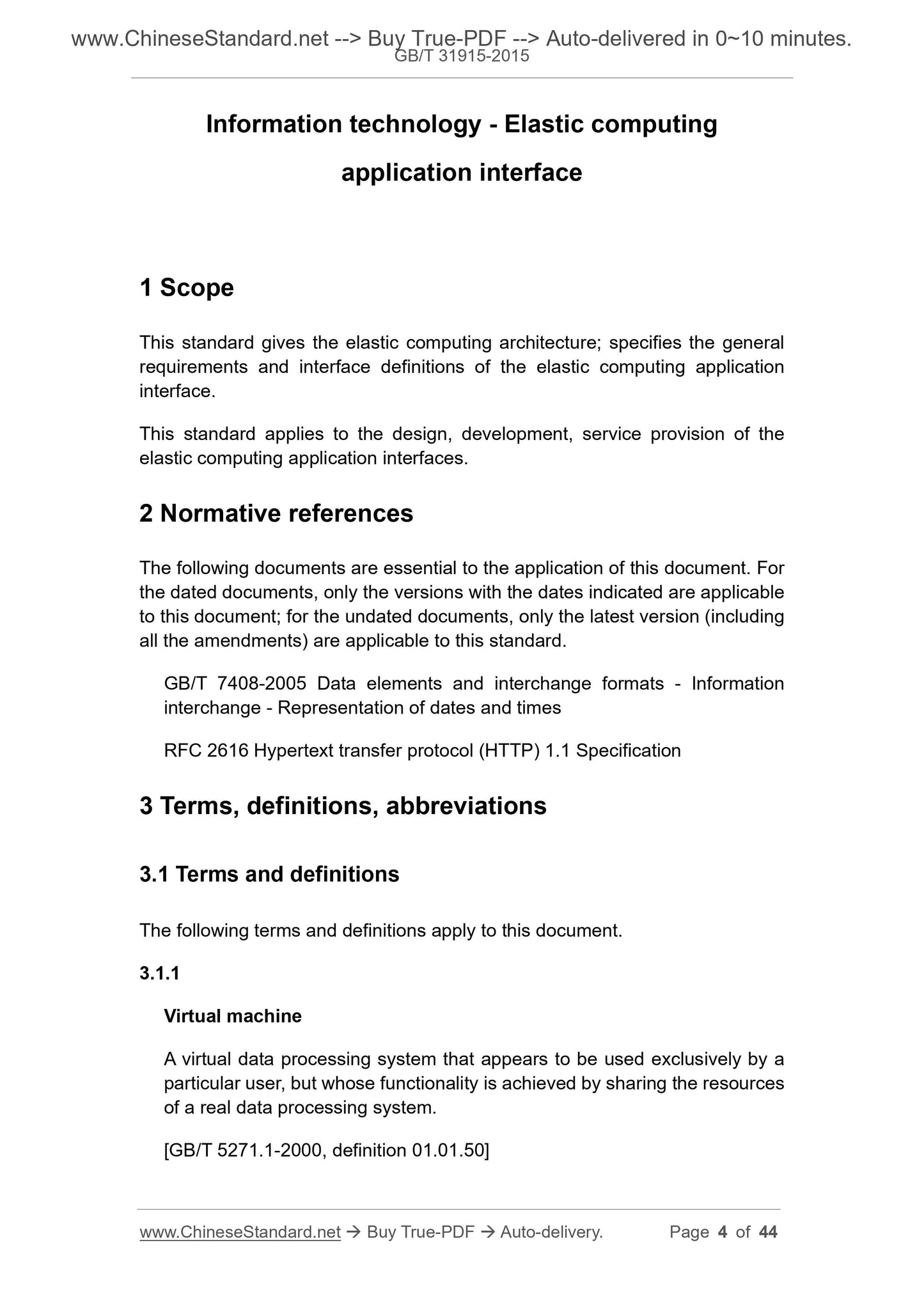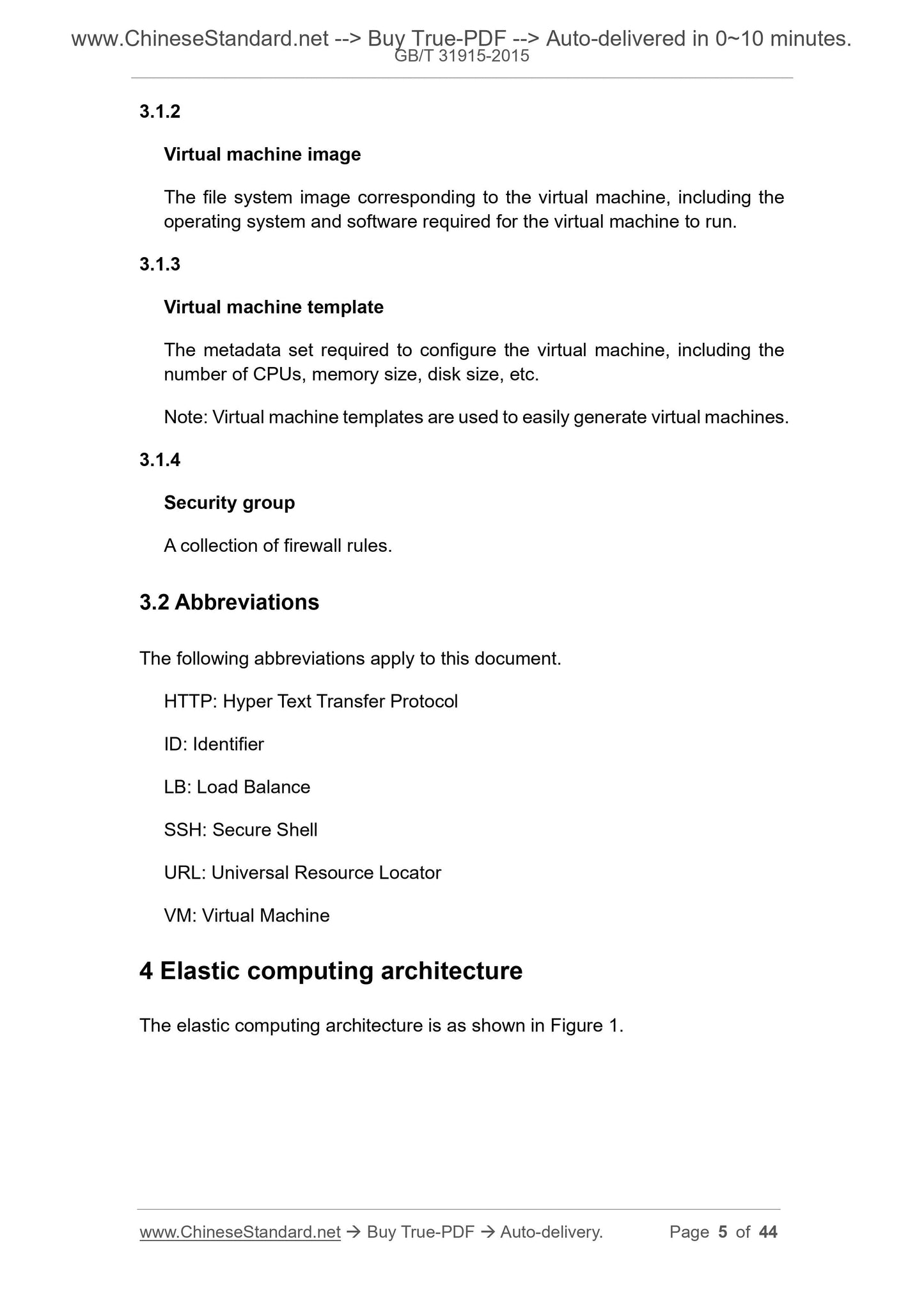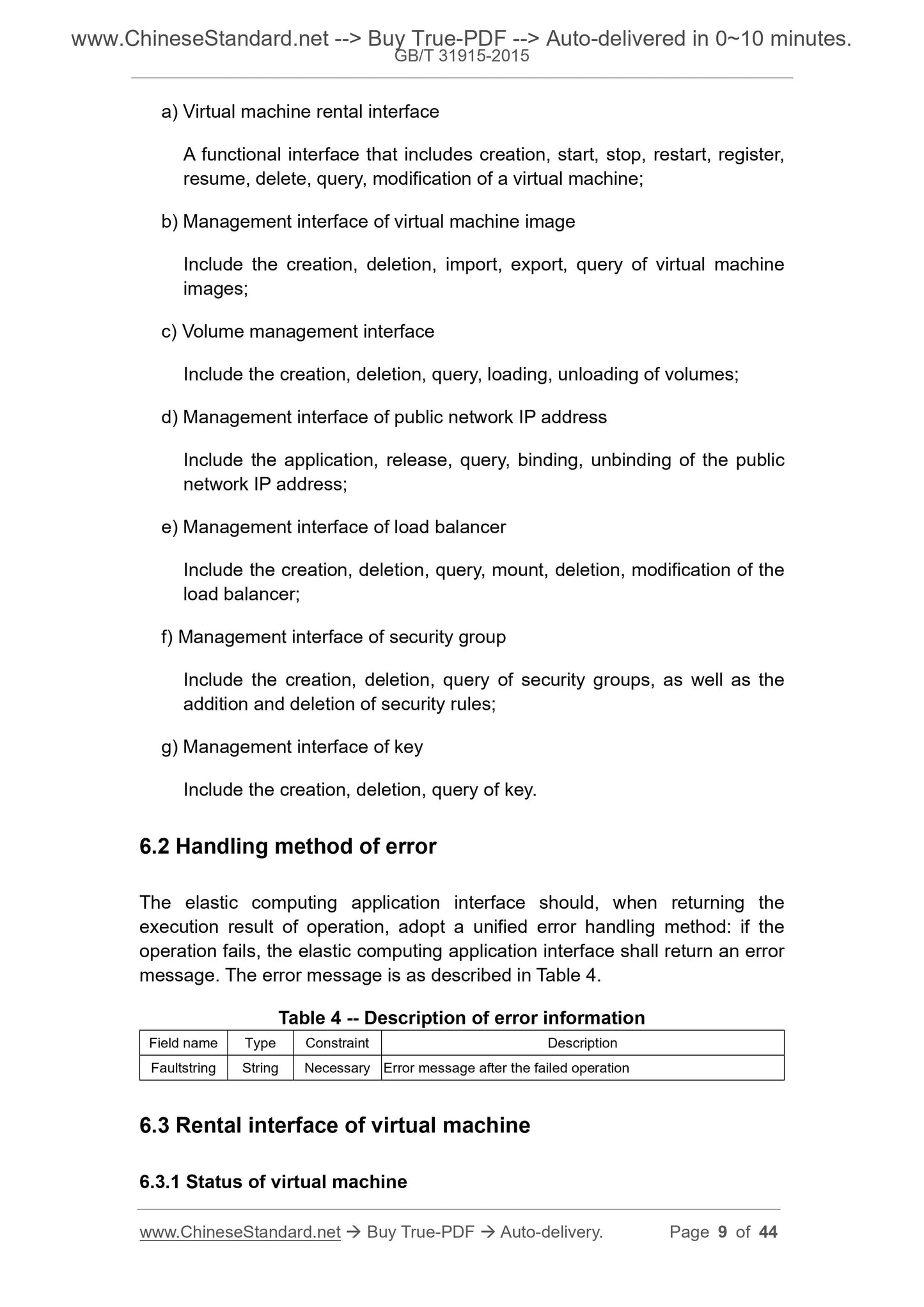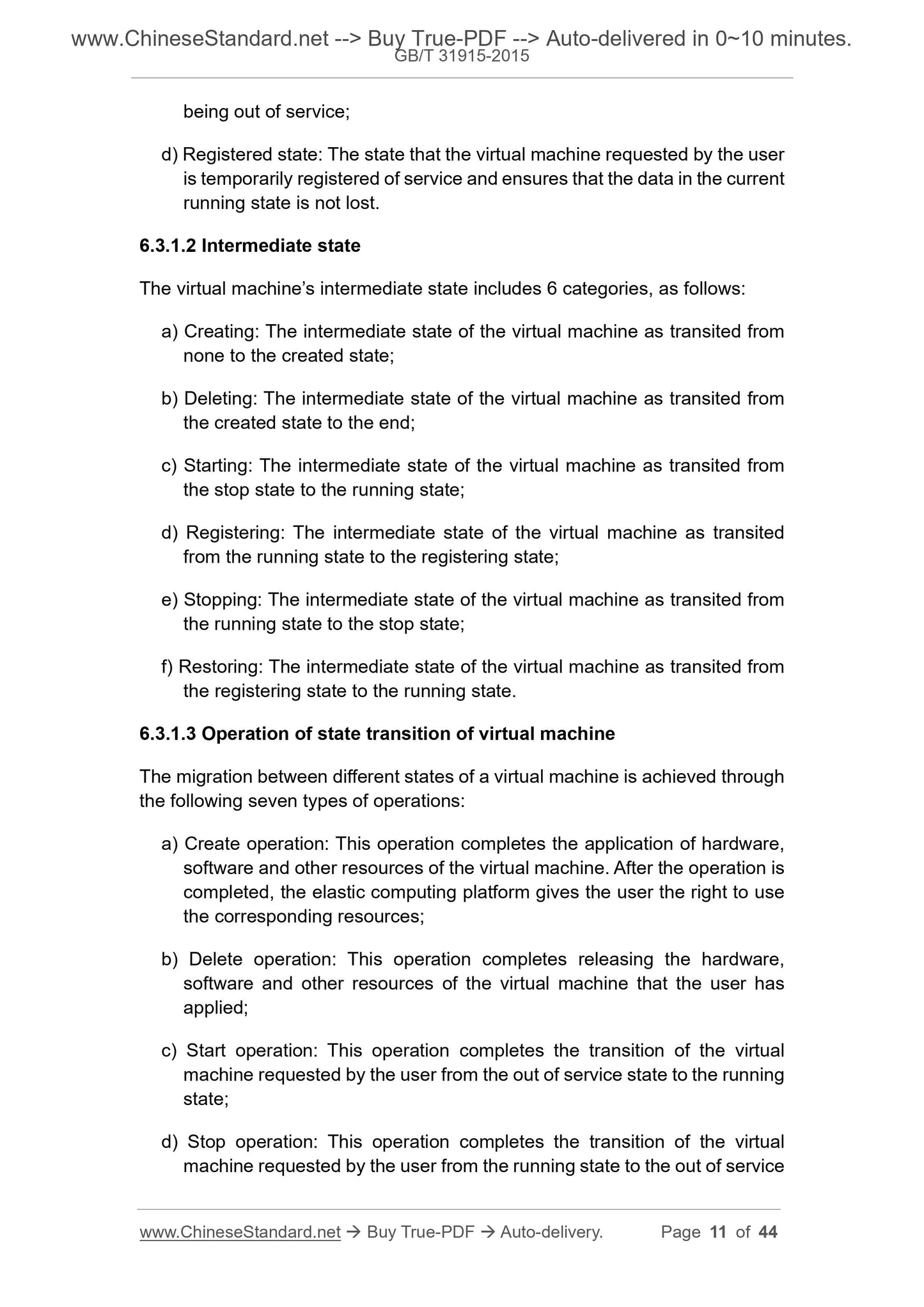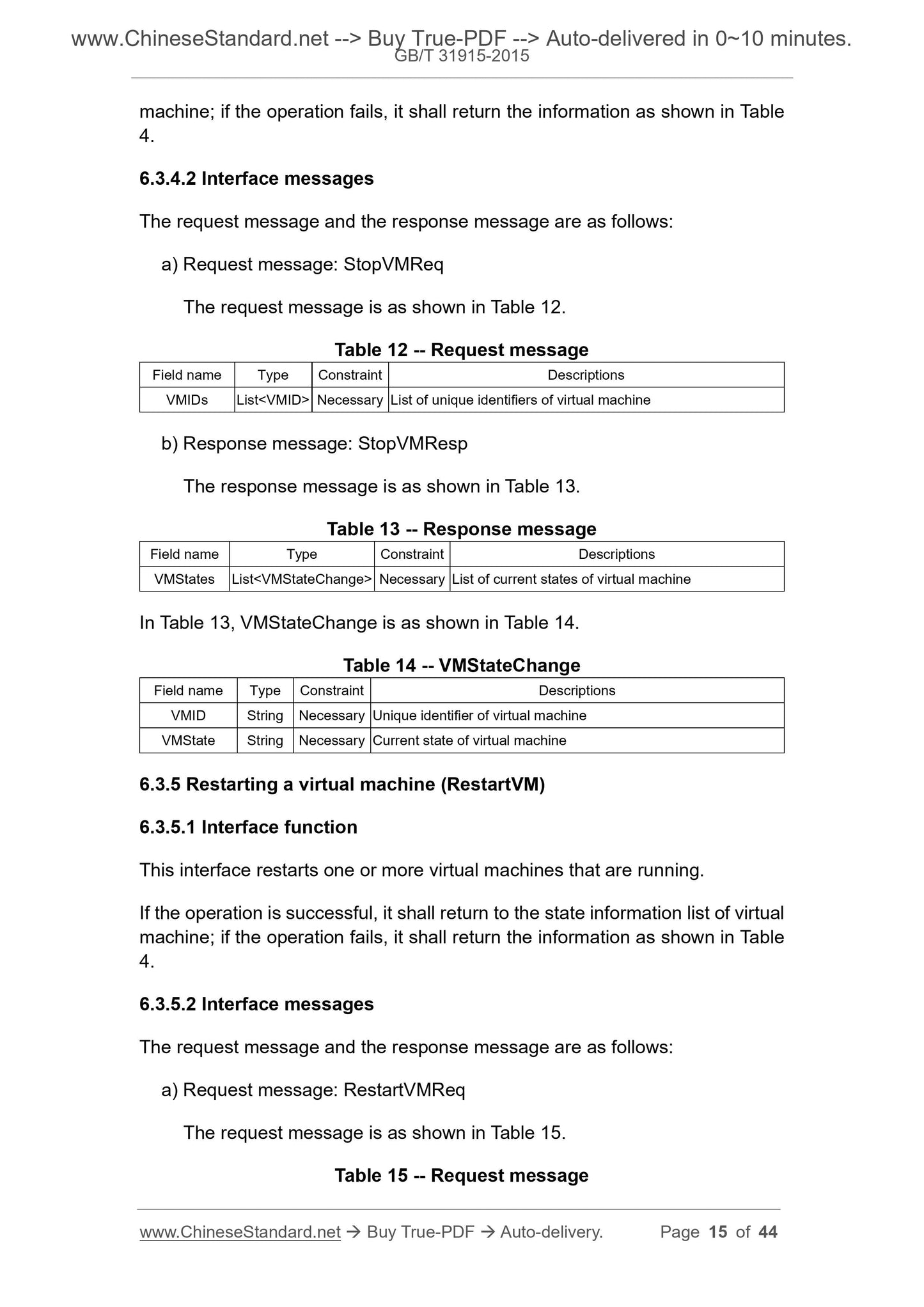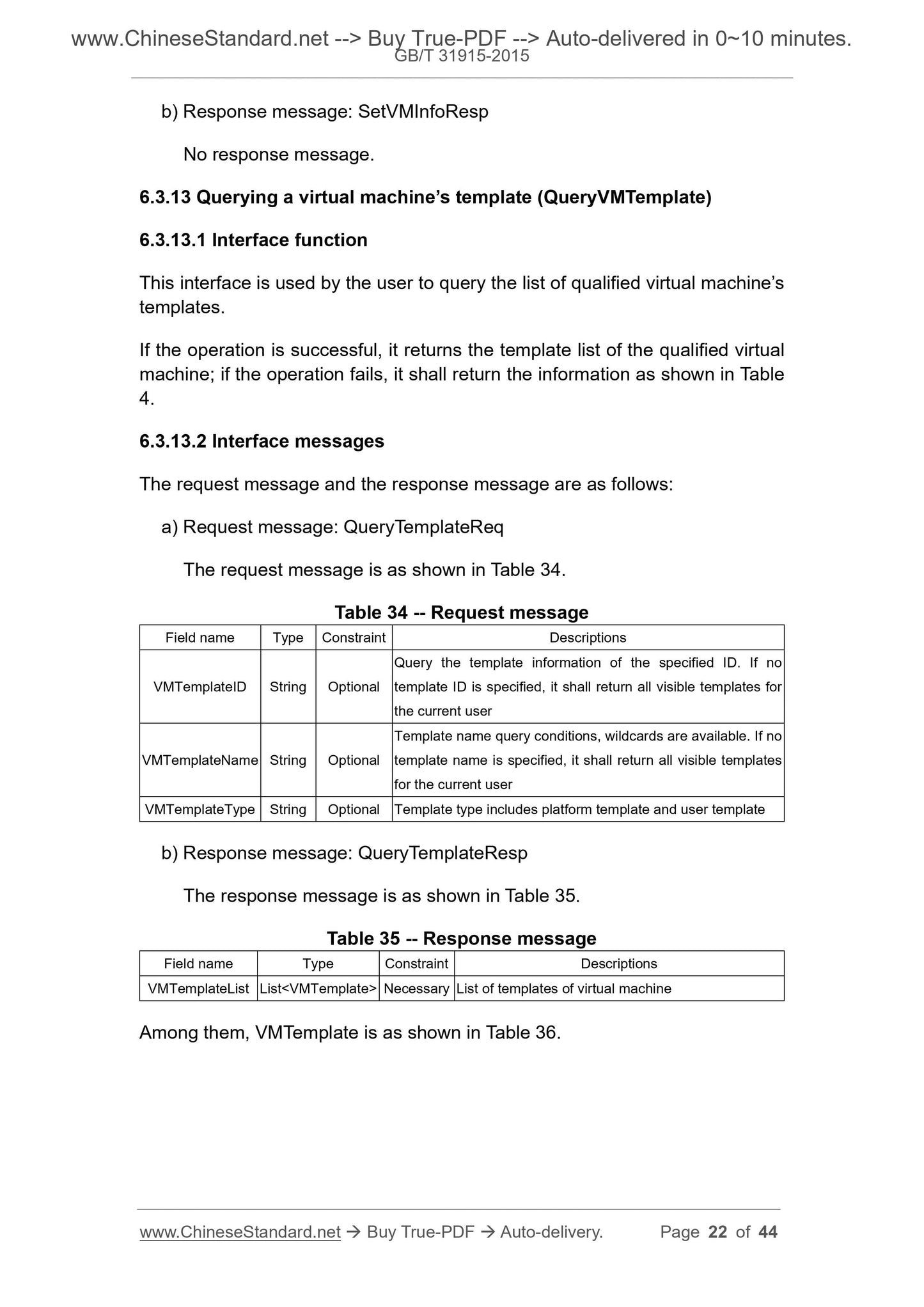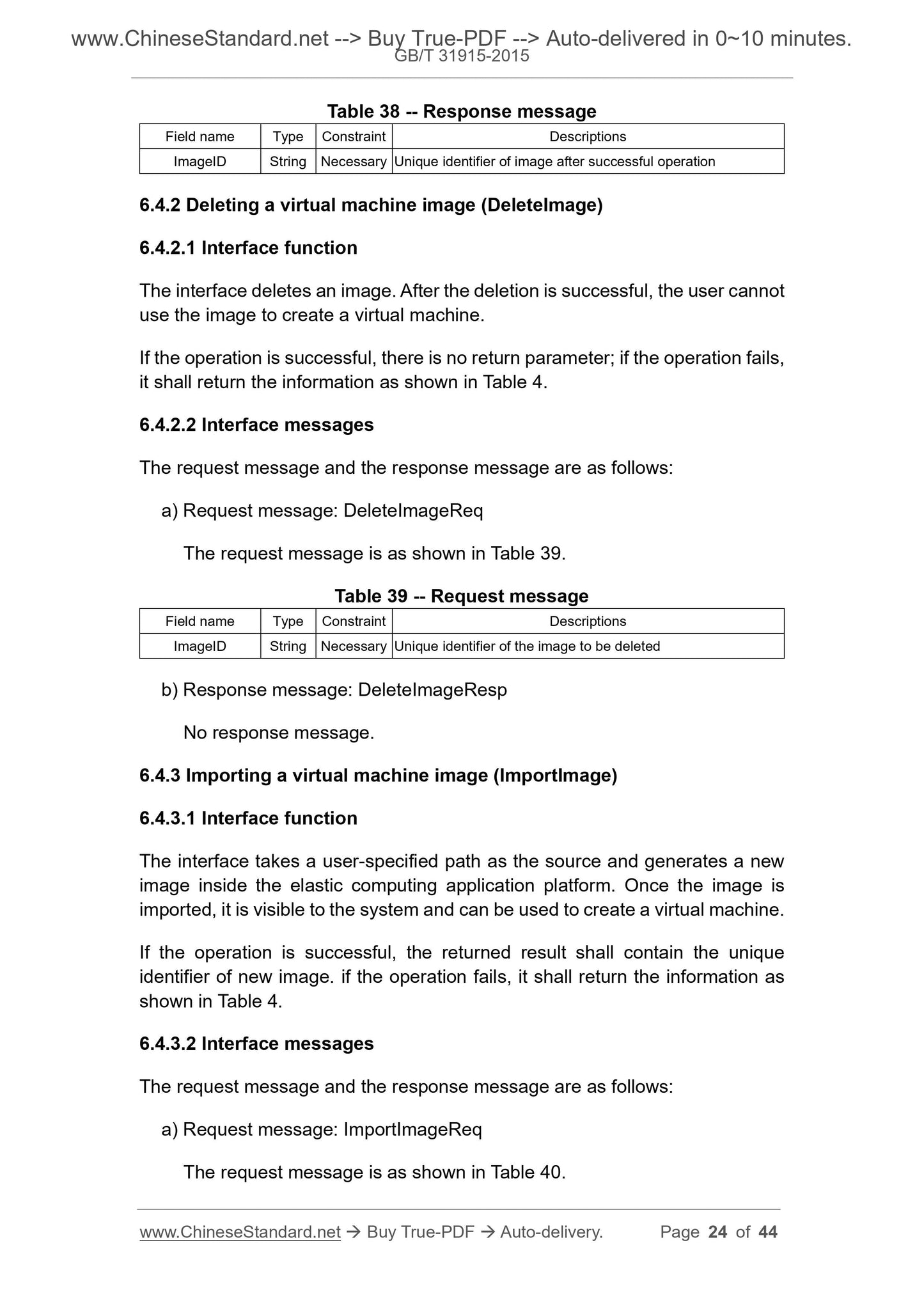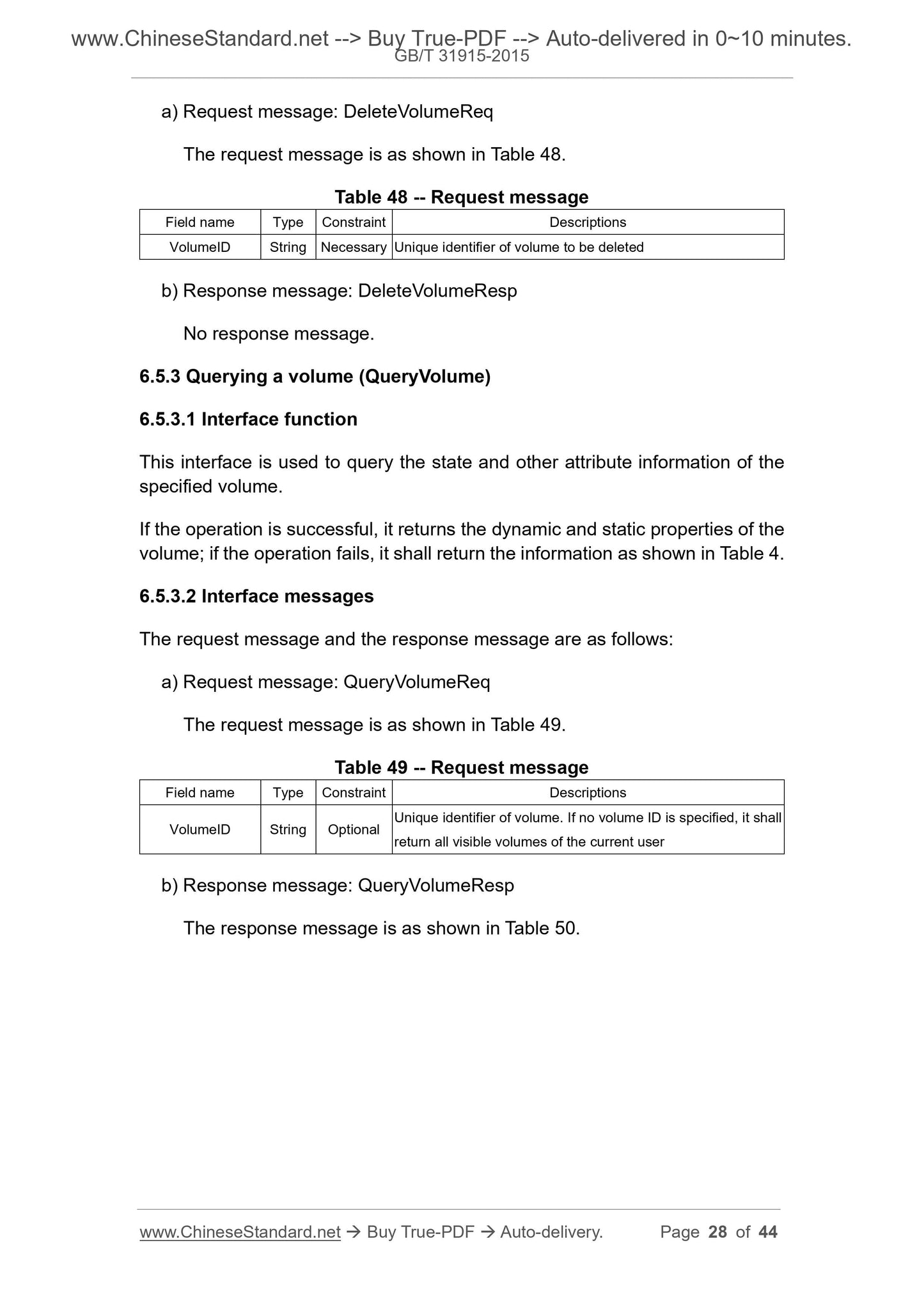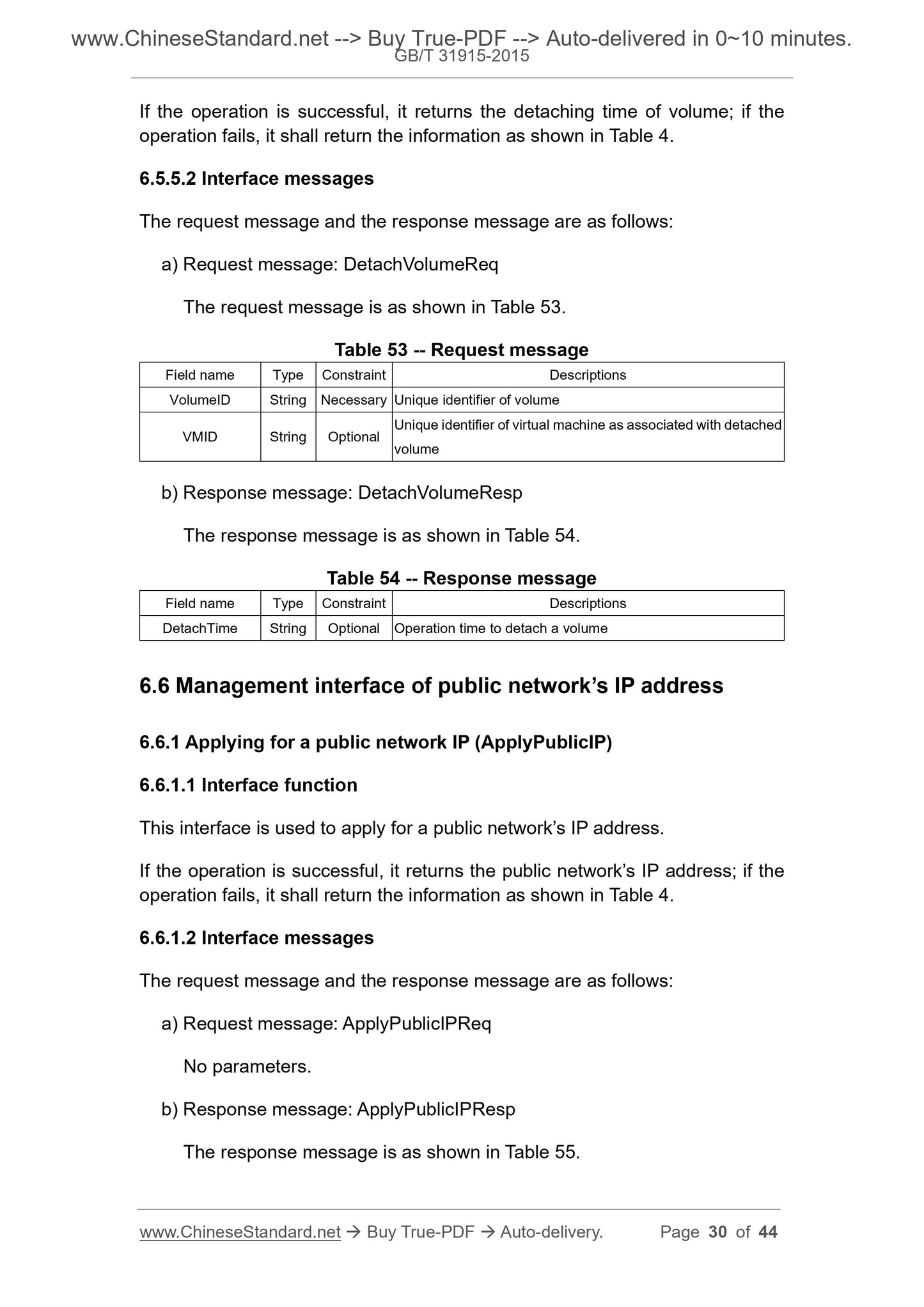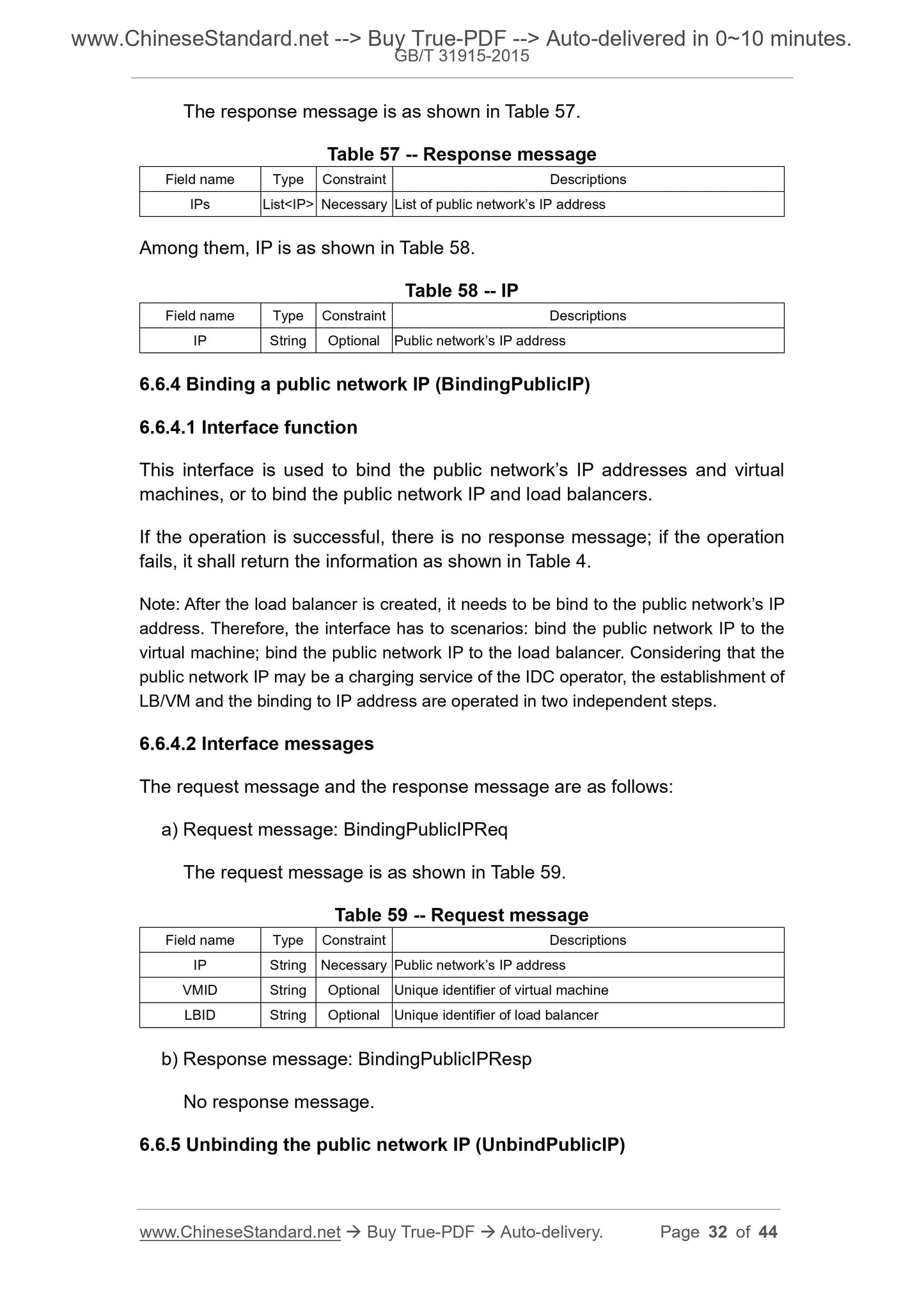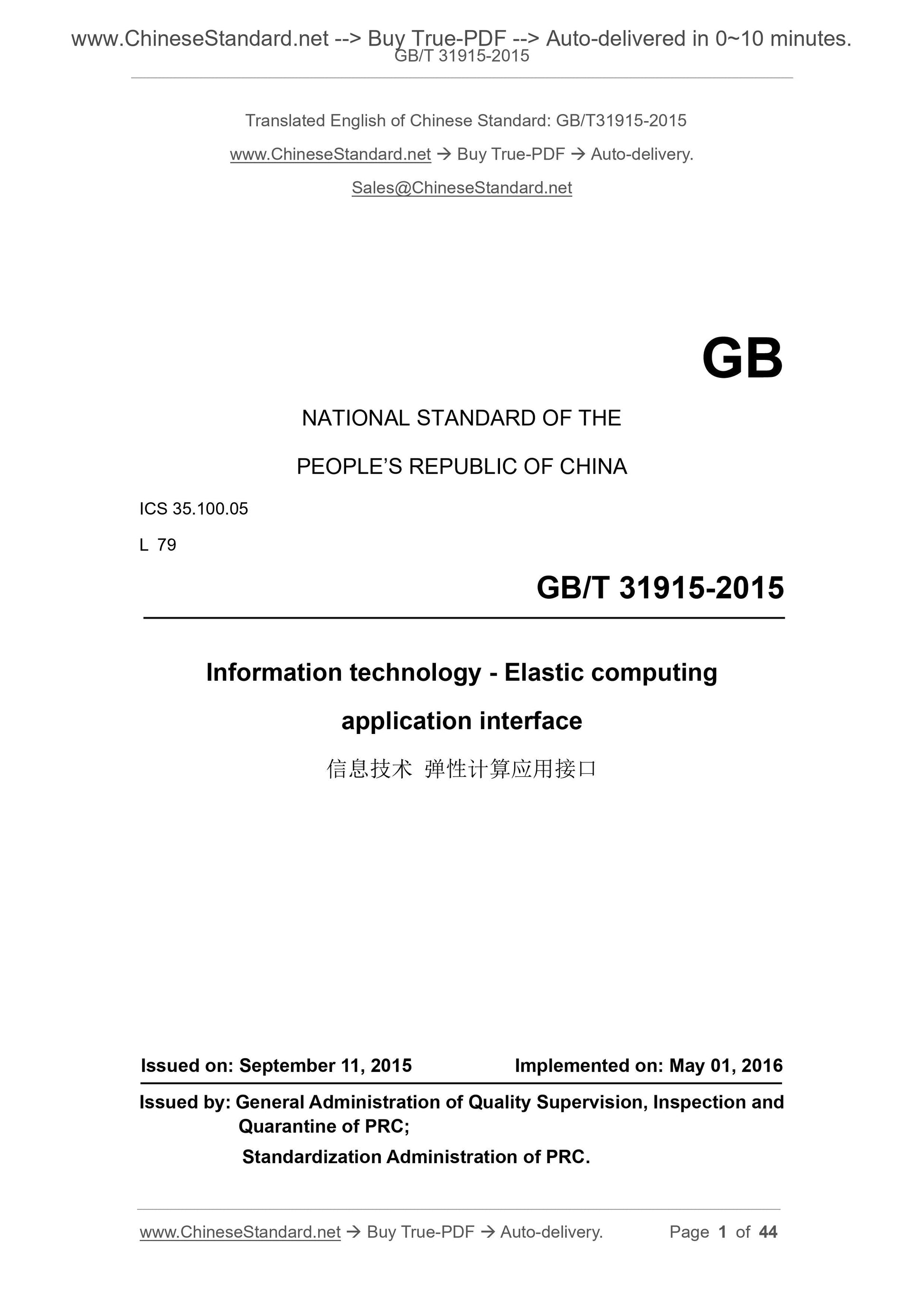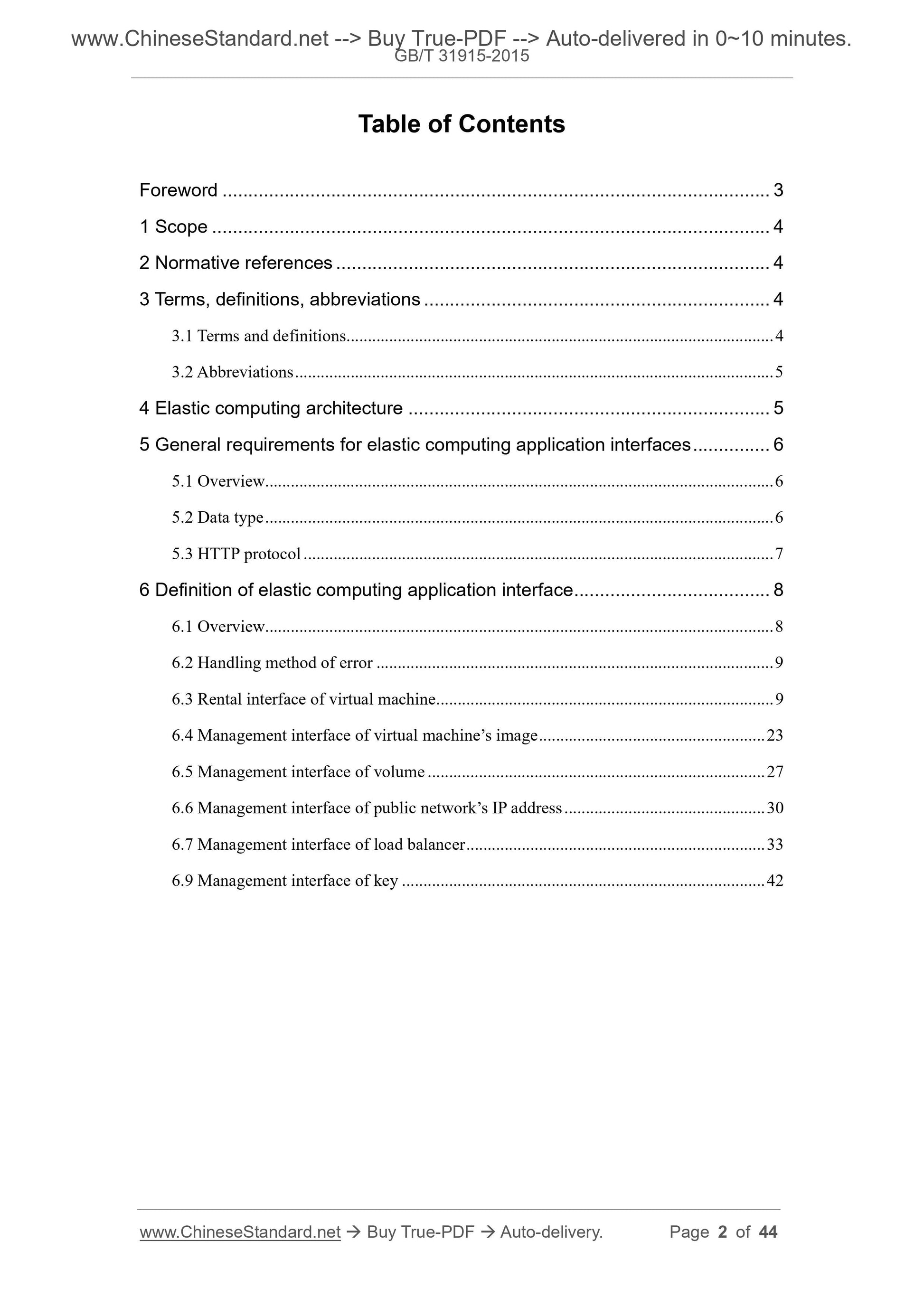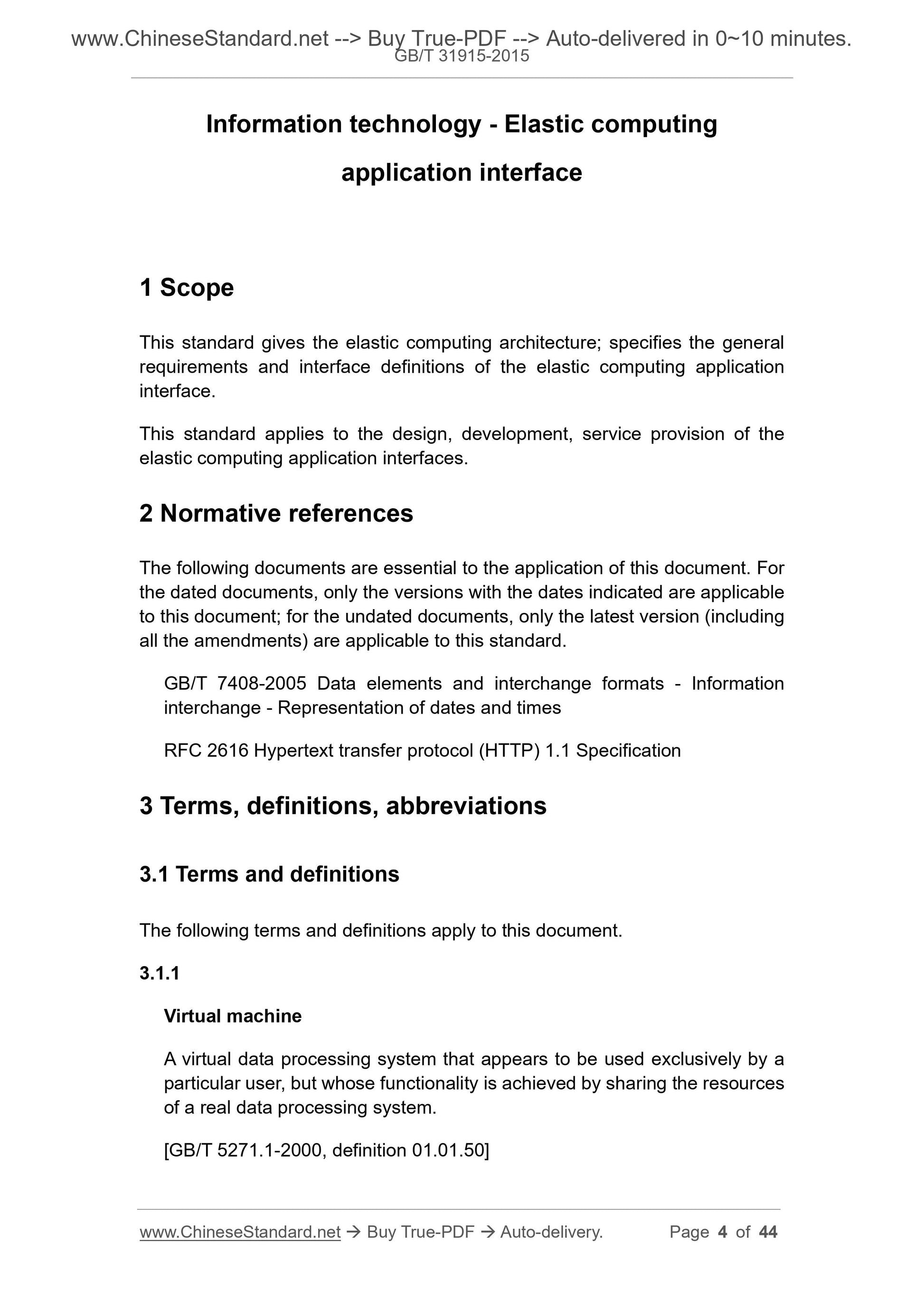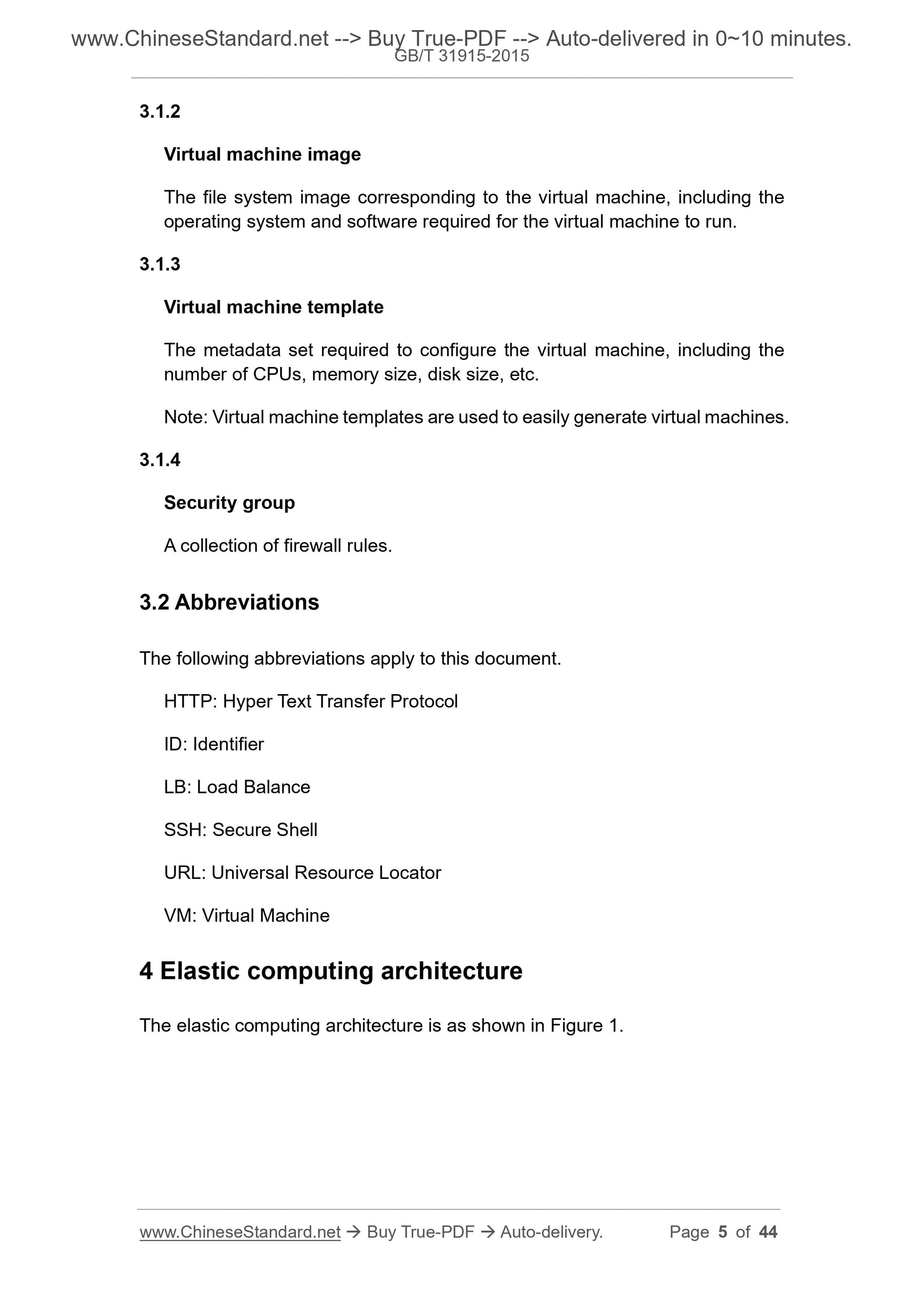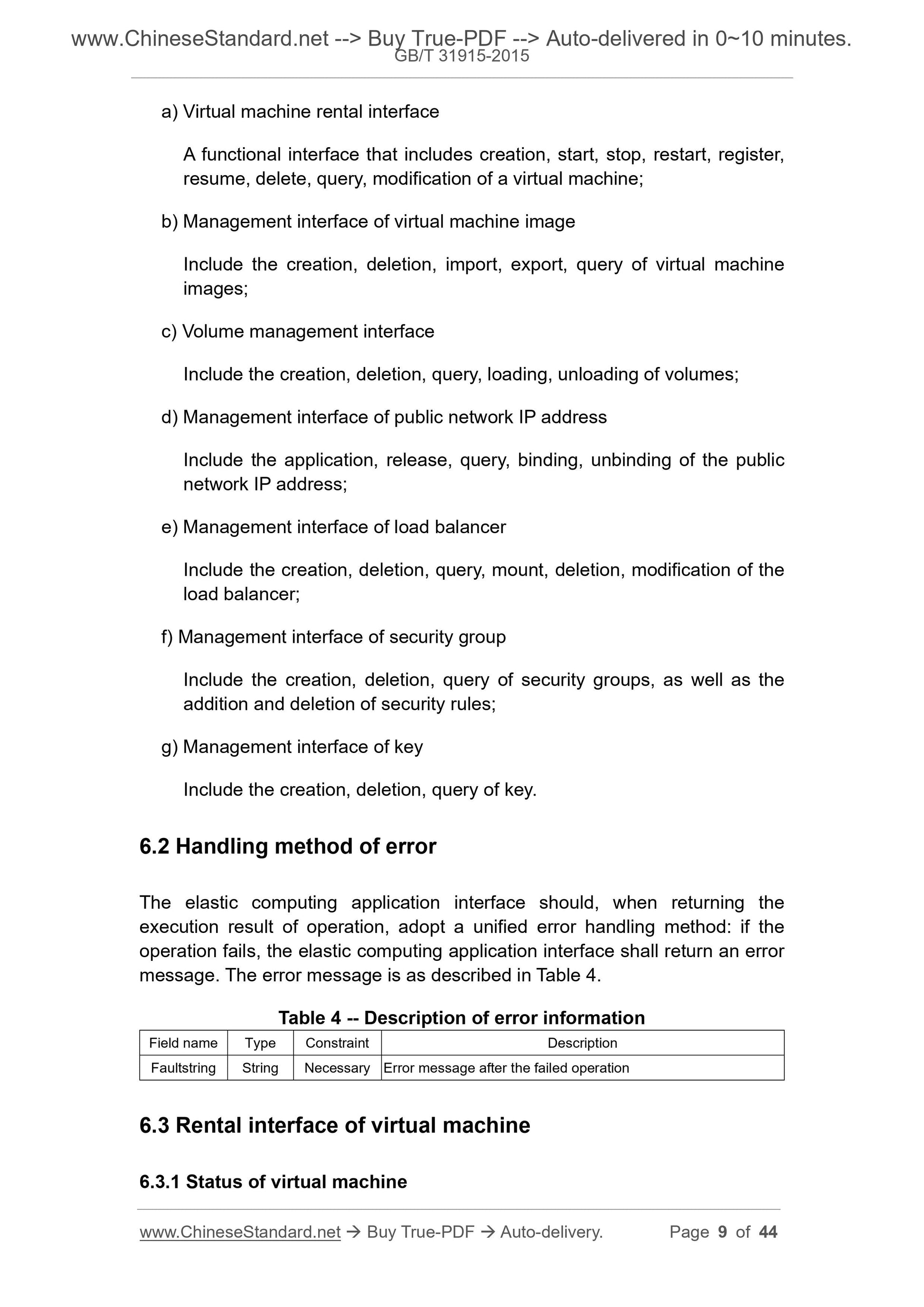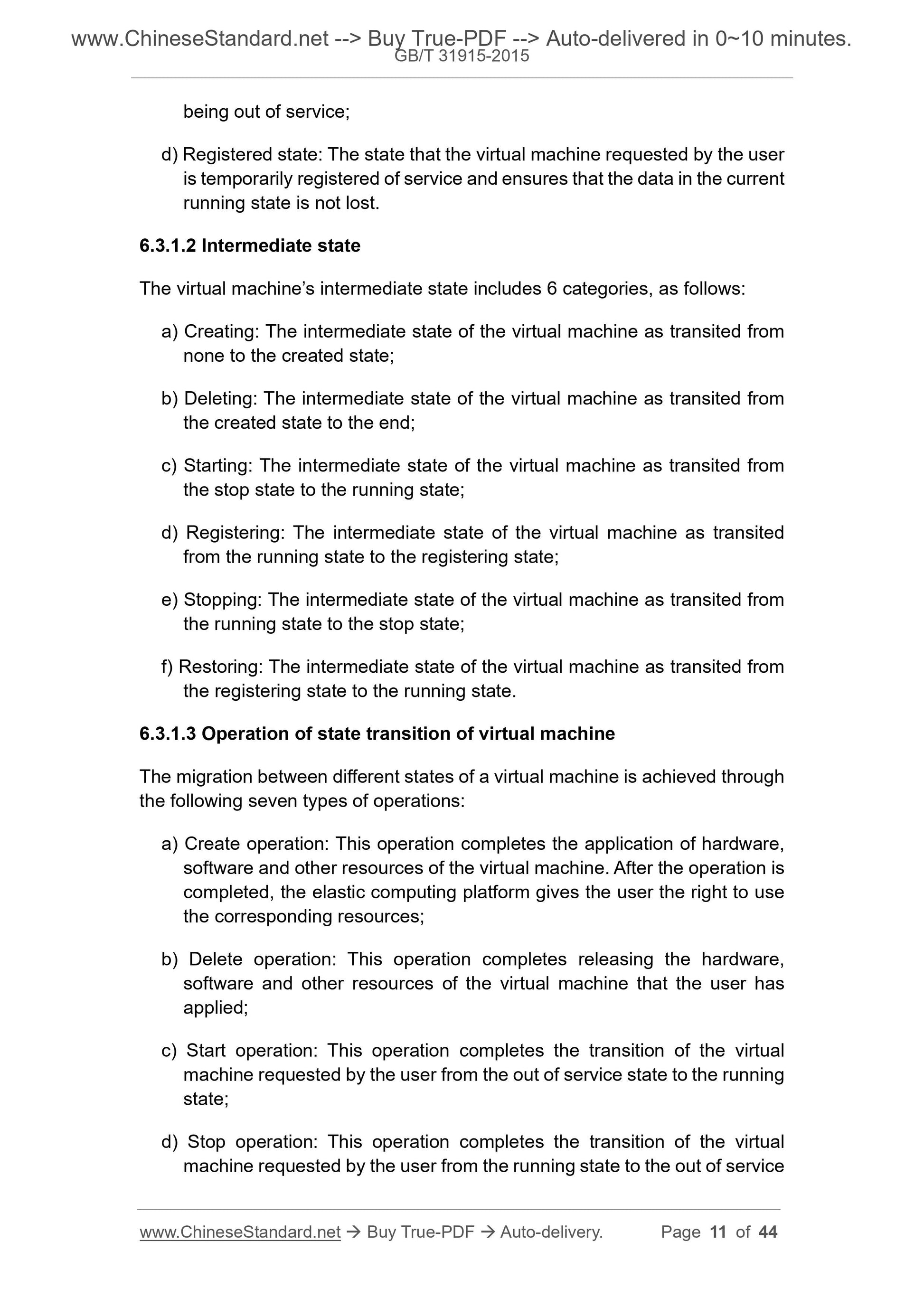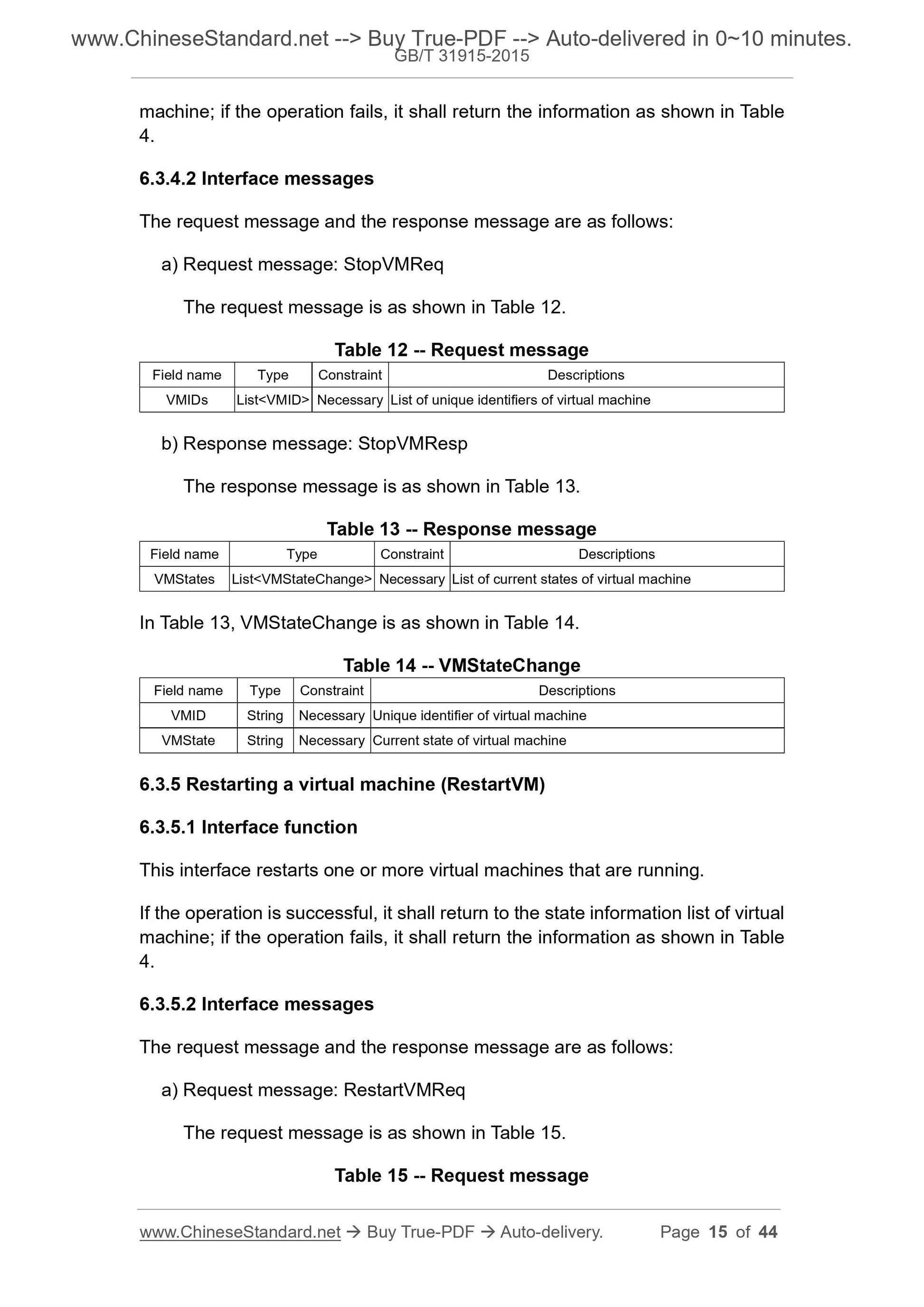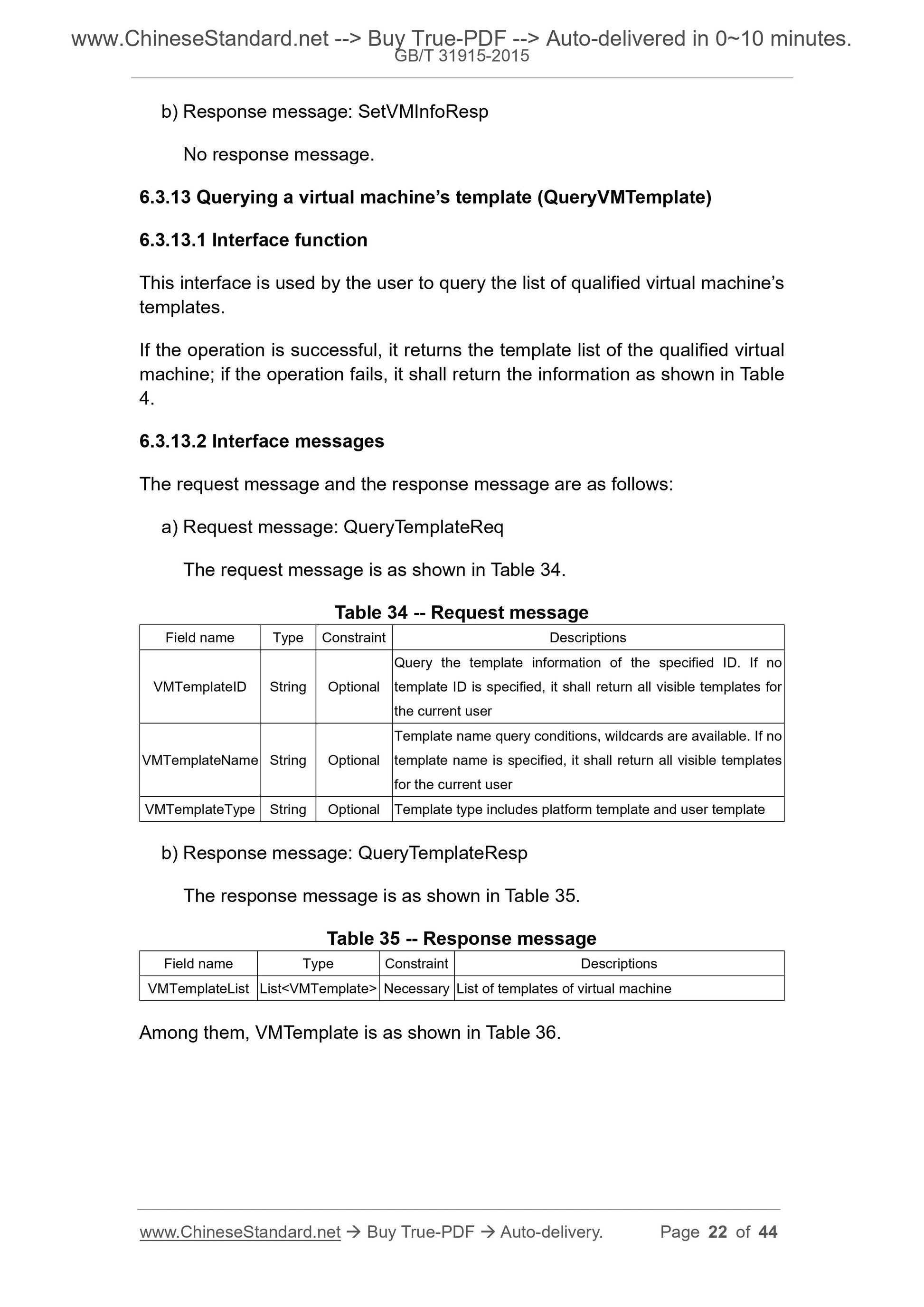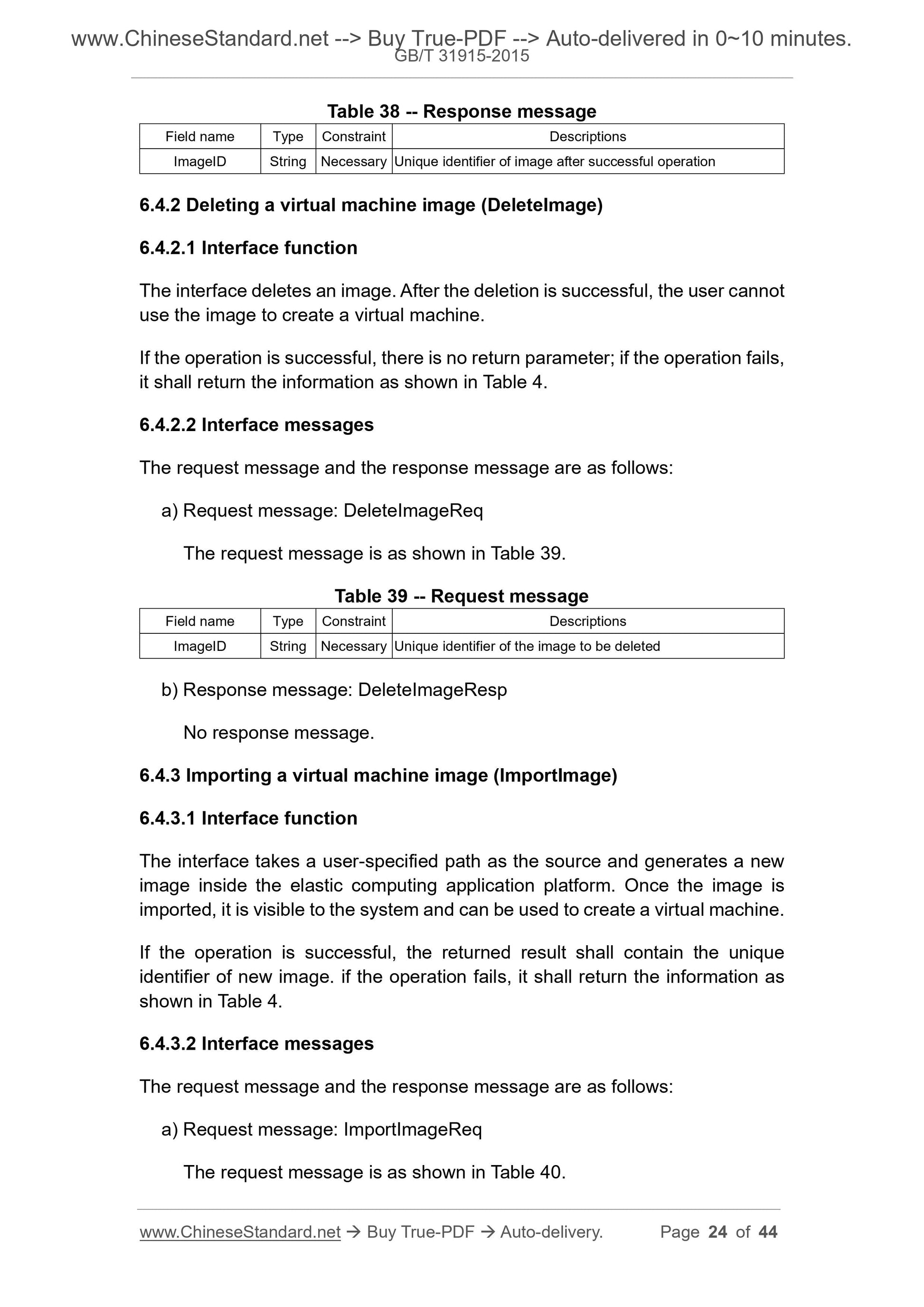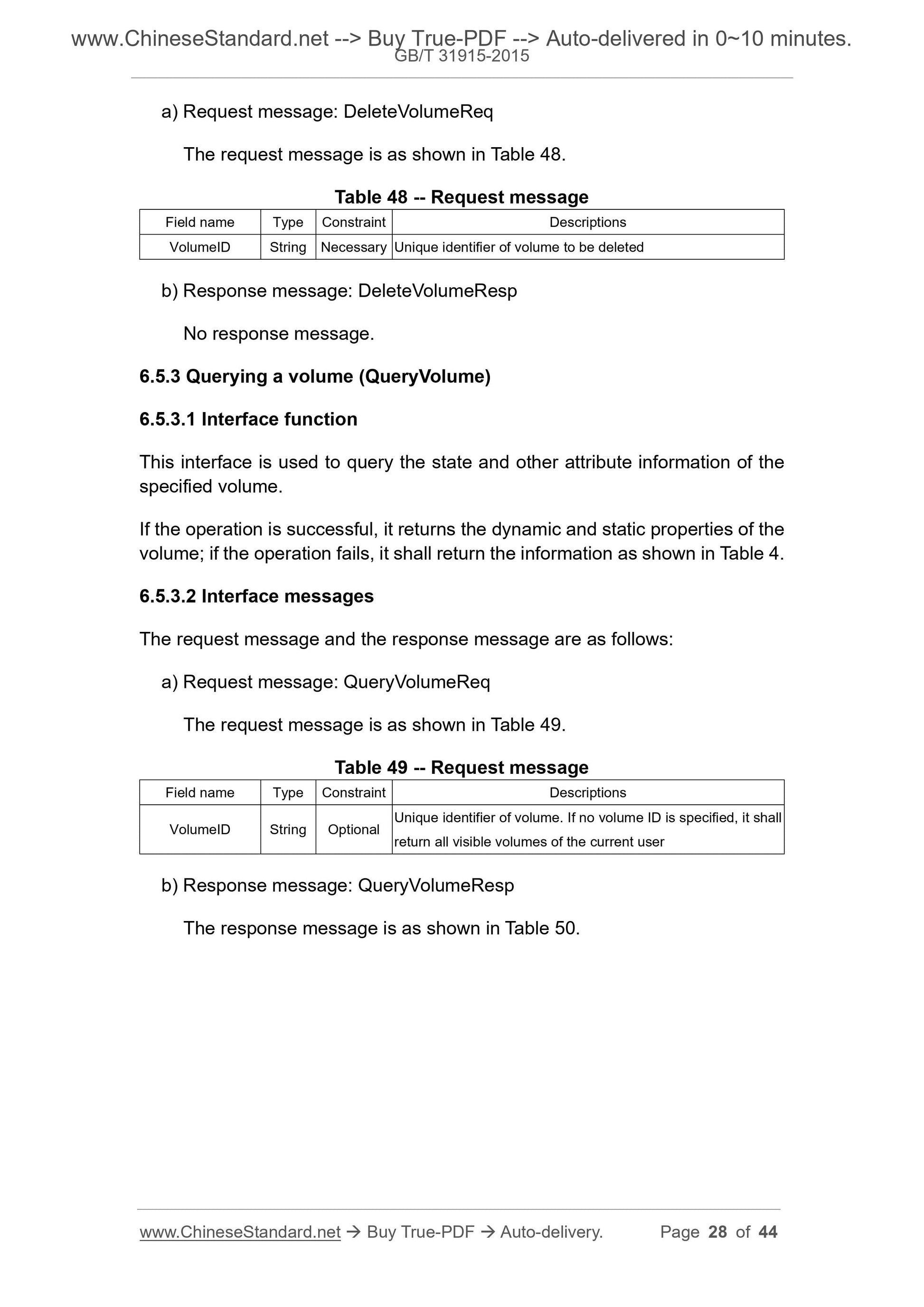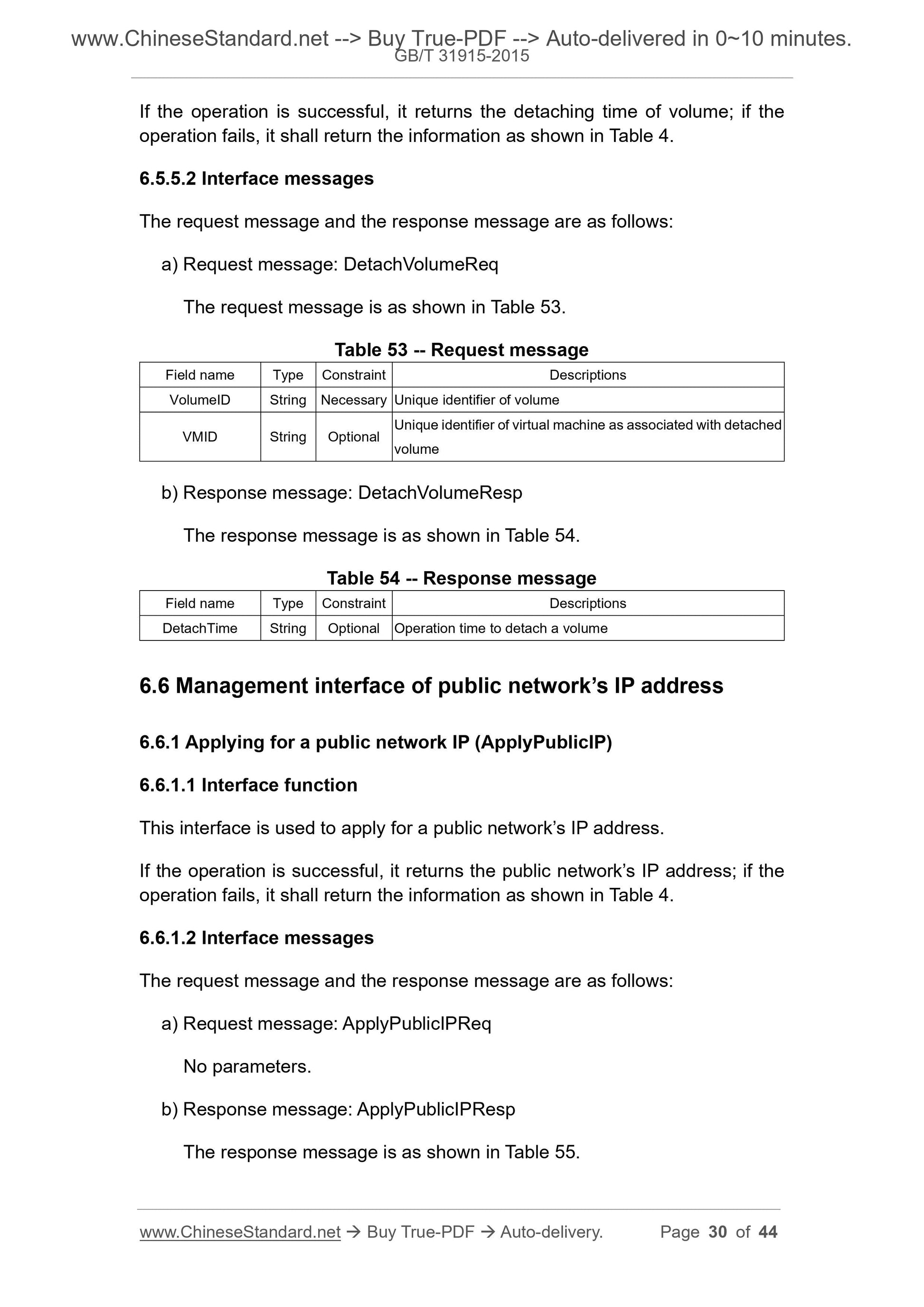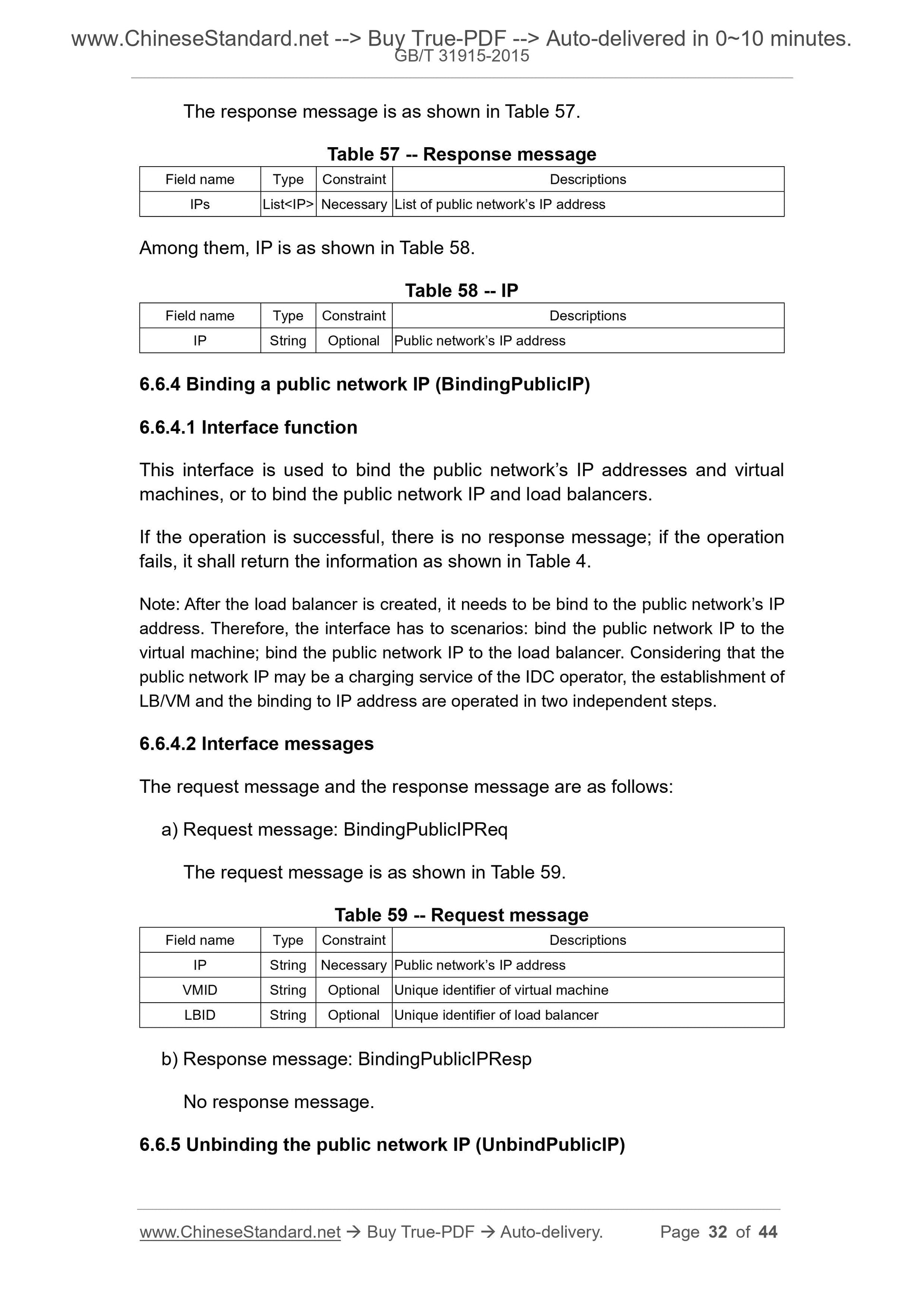1
/
of
12
PayPal, credit cards. Download editable-PDF & invoice In 1 second!
GB/T 31915-2015 English PDF (GBT31915-2015)
GB/T 31915-2015 English PDF (GBT31915-2015)
Regular price
$310.00 USD
Regular price
Sale price
$310.00 USD
Unit price
/
per
Shipping calculated at checkout.
Couldn't load pickup availability
Delivery: 3 seconds. Download true-PDF + Invoice.
Get QUOTATION in 1-minute: Click GB/T 31915-2015
Historical versions: GB/T 31915-2015
Preview True-PDF (Reload/Scroll if blank)
GB/T 31915-2015: Information technology -- Elastic computing application interface
GB/T 31915-2015
NATIONAL STANDARD OF THE
PEOPLE’S REPUBLIC OF CHINA
ICS 35.100.05
L 79
Information technology - Elastic computing
application interface
ISSUED ON: SEPTEMBER 11, 2015
IMPLEMENTED ON: MAY 01, 2016
Issued by: General Administration of Quality Supervision, Inspection and
Quarantine of PRC;
Standardization Administration of PRC.
Table of Contents
Foreword ... 3
1 Scope ... 4
2 Normative references ... 4
3 Terms, definitions, abbreviations ... 4
3.1 Terms and definitions ... 4
3.2 Abbreviations ... 5
4 Elastic computing architecture ... 5
5 General requirements for elastic computing application interfaces ... 6
5.1 Overview ... 6
5.2 Data type ... 6
5.3 HTTP protocol ... 7
6 Definition of elastic computing application interface ... 8
6.1 Overview ... 8
6.2 Handling method of error ... 9
6.3 Rental interface of virtual machine ... 9
6.4 Management interface of virtual machine’s image ... 23
6.5 Management interface of volume ... 27
6.6 Management interface of public network’s IP address ... 30
6.7 Management interface of load balancer ... 33
6.9 Management interface of key ... 42
Information technology - Elastic computing
application interface
1 Scope
This standard gives the elastic computing architecture; specifies the general
requirements and interface definitions of the elastic computing application
interface.
This standard applies to the design, development, service provision of the
elastic computing application interfaces.
2 Normative references
The following documents are essential to the application of this document. For
the dated documents, only the versions with the dates indicated are applicable
to this document; for the undated documents, only the latest version (including
all the amendments) are applicable to this standard.
GB/T 7408-2005 Data elements and interchange formats - Information
interchange - Representation of dates and times
RFC 2616 Hypertext transfer protocol (HTTP) 1.1 Specification
3 Terms, definitions, abbreviations
3.1 Terms and definitions
The following terms and definitions apply to this document.
3.1.1
Virtual machine
A virtual data processing system that appears to be used exclusively by a
particular user, but whose functionality is achieved by sharing the resources
of a real data processing system.
[GB/T 5271.1-2000, definition 01.01.50]
3.1.2
Virtual machine image
The file system image corresponding to the virtual machine, including the
operating system and software required for the virtual machine to run.
3.1.3
Virtual machine template
The metadata set required to configure the virtual machine, including the
number of CPUs, memory size, disk size, etc.
Note: Virtual machine templates are used to easily generate virtual machines.
3.1.4
Security group
A collection of firewall rules.
3.2 Abbreviations
The following abbreviations apply to this document.
HTTP: Hyper Text Transfer Protocol
ID: Identifier
LB: Load Balance
SSH: Secure Shell
URL: Universal Resource Locator
VM: Virtual Machine
4 Elastic computing architecture
The elastic computing architecture is as shown in Figure 1.
a) Virtual machine rental interface
A functional interface that includes creation, start, stop, restart, register,
resume, delete, query, modification of a virtual machine;
b) Management interface of virtual machine image
Include the creation, deletion, import, export, query of virtual machine
images;
c) Volume management interface
Include the creation, deletion, query, loading, unloading of volumes;
d) Management interface of public network IP address
Include the application, release, query, binding, unbinding of the public
network IP address;
e) Management interface of load balancer
Include the creation, deletion, query, mount, deletion, modification of the
load balancer;
f) Management interface of security group
Include the creation, deletion, query of security groups, as well as the
addition and deletion of security rules;
g) Management interface of key
Include the creation, deletion, query of key.
6.2 Handling method of error
The elastic computing application interface should, when returning the
execution result of operation, adopt a unified error handling method: if the
operation fails, the elastic computing application interface shall return an error
message. The error message is as described in Table 4.
Table 4 -- Description of error information
Field name Type Constraint Description
Faultstring String Necessary Error message after the failed operation
6.3 Rental interface of virtual machine
6.3.1 Status of virtual machine
being out of service;
d) Registered state: The state that the virtual machine requested by the user
is temporarily registered of service and ensures that the data in the current
running state is not lost.
6.3.1.2 Intermediate state
The virtual machine’s intermediate state includes 6 categories, as follows:
a) Creating: The intermediate state of the virtual machine as transited from
none to the created state;
b) Deleting: The intermediate state of the virtual machine as transited from
the created state to the end;
c) Starting: The intermediate state of the virtual machine as transited from
the stop state to the running state;
d) Registering: The intermediate state of the virtual machine as transited
from the running state to the registering state;
e) Stopping: The intermediate state of the virtual machine as transited from
the running state to the stop state;
f) Restoring: The intermediate state of the virtual machine as transited from
the registering state to the running state.
6.3.1.3 Operation of state transition of virtual machine
The migration between different states of a virtual machine is achieved through
the following seven types of operations:
a) Create operation: This operation completes the application of hardware,
software and other resources of the virtual machine. After the operation is
completed, the elastic computing platform gives the user the right to use
the corresponding resources;
b) Delete operation: This operation completes releasing the hardware,
software and other resources of the virtual machine that the user has
applied;
c) Start operation: This operation completes the transition of the virtual
machine requested by the user from the out of service state to the running
state;
d) Stop operation: This operation completes the transition of the virtual
machine requested by the user from the running state to the out of service
machine; if the operation fails, it shall return the information as shown in Table
4.
6.3.4.2 Interface messages
The request message and the response message are as follows:
a) Request message: StopVMReq
The request message is as shown in Table 12.
Table 12 -- Request message
Field name Type Constraint Descriptions
VMIDs List< VMID> Necessary List of unique identifiers of virtual machine
b) Response message: StopVMResp
The response message is as shown in Table 13.
Table 13 -- Response message
Field name Type Constraint Descriptions
VMStates List< VMStateChange> Necessary List of current states of virtual machine
In Table 13, VMStateChange is as shown in Table 14.
Table 14 -- VMStateChange
Field name Type Constraint Descriptions
VMID String Necessary Unique identi...
Get QUOTATION in 1-minute: Click GB/T 31915-2015
Historical versions: GB/T 31915-2015
Preview True-PDF (Reload/Scroll if blank)
GB/T 31915-2015: Information technology -- Elastic computing application interface
GB/T 31915-2015
NATIONAL STANDARD OF THE
PEOPLE’S REPUBLIC OF CHINA
ICS 35.100.05
L 79
Information technology - Elastic computing
application interface
ISSUED ON: SEPTEMBER 11, 2015
IMPLEMENTED ON: MAY 01, 2016
Issued by: General Administration of Quality Supervision, Inspection and
Quarantine of PRC;
Standardization Administration of PRC.
Table of Contents
Foreword ... 3
1 Scope ... 4
2 Normative references ... 4
3 Terms, definitions, abbreviations ... 4
3.1 Terms and definitions ... 4
3.2 Abbreviations ... 5
4 Elastic computing architecture ... 5
5 General requirements for elastic computing application interfaces ... 6
5.1 Overview ... 6
5.2 Data type ... 6
5.3 HTTP protocol ... 7
6 Definition of elastic computing application interface ... 8
6.1 Overview ... 8
6.2 Handling method of error ... 9
6.3 Rental interface of virtual machine ... 9
6.4 Management interface of virtual machine’s image ... 23
6.5 Management interface of volume ... 27
6.6 Management interface of public network’s IP address ... 30
6.7 Management interface of load balancer ... 33
6.9 Management interface of key ... 42
Information technology - Elastic computing
application interface
1 Scope
This standard gives the elastic computing architecture; specifies the general
requirements and interface definitions of the elastic computing application
interface.
This standard applies to the design, development, service provision of the
elastic computing application interfaces.
2 Normative references
The following documents are essential to the application of this document. For
the dated documents, only the versions with the dates indicated are applicable
to this document; for the undated documents, only the latest version (including
all the amendments) are applicable to this standard.
GB/T 7408-2005 Data elements and interchange formats - Information
interchange - Representation of dates and times
RFC 2616 Hypertext transfer protocol (HTTP) 1.1 Specification
3 Terms, definitions, abbreviations
3.1 Terms and definitions
The following terms and definitions apply to this document.
3.1.1
Virtual machine
A virtual data processing system that appears to be used exclusively by a
particular user, but whose functionality is achieved by sharing the resources
of a real data processing system.
[GB/T 5271.1-2000, definition 01.01.50]
3.1.2
Virtual machine image
The file system image corresponding to the virtual machine, including the
operating system and software required for the virtual machine to run.
3.1.3
Virtual machine template
The metadata set required to configure the virtual machine, including the
number of CPUs, memory size, disk size, etc.
Note: Virtual machine templates are used to easily generate virtual machines.
3.1.4
Security group
A collection of firewall rules.
3.2 Abbreviations
The following abbreviations apply to this document.
HTTP: Hyper Text Transfer Protocol
ID: Identifier
LB: Load Balance
SSH: Secure Shell
URL: Universal Resource Locator
VM: Virtual Machine
4 Elastic computing architecture
The elastic computing architecture is as shown in Figure 1.
a) Virtual machine rental interface
A functional interface that includes creation, start, stop, restart, register,
resume, delete, query, modification of a virtual machine;
b) Management interface of virtual machine image
Include the creation, deletion, import, export, query of virtual machine
images;
c) Volume management interface
Include the creation, deletion, query, loading, unloading of volumes;
d) Management interface of public network IP address
Include the application, release, query, binding, unbinding of the public
network IP address;
e) Management interface of load balancer
Include the creation, deletion, query, mount, deletion, modification of the
load balancer;
f) Management interface of security group
Include the creation, deletion, query of security groups, as well as the
addition and deletion of security rules;
g) Management interface of key
Include the creation, deletion, query of key.
6.2 Handling method of error
The elastic computing application interface should, when returning the
execution result of operation, adopt a unified error handling method: if the
operation fails, the elastic computing application interface shall return an error
message. The error message is as described in Table 4.
Table 4 -- Description of error information
Field name Type Constraint Description
Faultstring String Necessary Error message after the failed operation
6.3 Rental interface of virtual machine
6.3.1 Status of virtual machine
being out of service;
d) Registered state: The state that the virtual machine requested by the user
is temporarily registered of service and ensures that the data in the current
running state is not lost.
6.3.1.2 Intermediate state
The virtual machine’s intermediate state includes 6 categories, as follows:
a) Creating: The intermediate state of the virtual machine as transited from
none to the created state;
b) Deleting: The intermediate state of the virtual machine as transited from
the created state to the end;
c) Starting: The intermediate state of the virtual machine as transited from
the stop state to the running state;
d) Registering: The intermediate state of the virtual machine as transited
from the running state to the registering state;
e) Stopping: The intermediate state of the virtual machine as transited from
the running state to the stop state;
f) Restoring: The intermediate state of the virtual machine as transited from
the registering state to the running state.
6.3.1.3 Operation of state transition of virtual machine
The migration between different states of a virtual machine is achieved through
the following seven types of operations:
a) Create operation: This operation completes the application of hardware,
software and other resources of the virtual machine. After the operation is
completed, the elastic computing platform gives the user the right to use
the corresponding resources;
b) Delete operation: This operation completes releasing the hardware,
software and other resources of the virtual machine that the user has
applied;
c) Start operation: This operation completes the transition of the virtual
machine requested by the user from the out of service state to the running
state;
d) Stop operation: This operation completes the transition of the virtual
machine requested by the user from the running state to the out of service
machine; if the operation fails, it shall return the information as shown in Table
4.
6.3.4.2 Interface messages
The request message and the response message are as follows:
a) Request message: StopVMReq
The request message is as shown in Table 12.
Table 12 -- Request message
Field name Type Constraint Descriptions
VMIDs List< VMID> Necessary List of unique identifiers of virtual machine
b) Response message: StopVMResp
The response message is as shown in Table 13.
Table 13 -- Response message
Field name Type Constraint Descriptions
VMStates List< VMStateChange> Necessary List of current states of virtual machine
In Table 13, VMStateChange is as shown in Table 14.
Table 14 -- VMStateChange
Field name Type Constraint Descriptions
VMID String Necessary Unique identi...
Share
